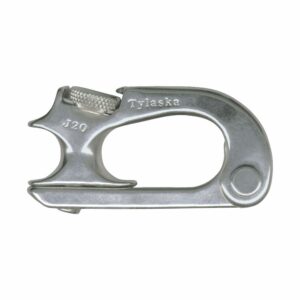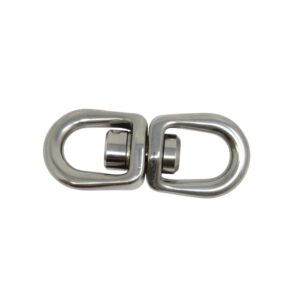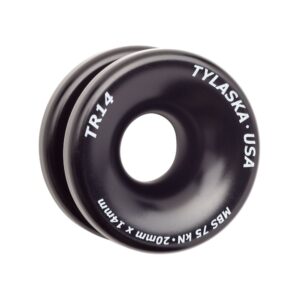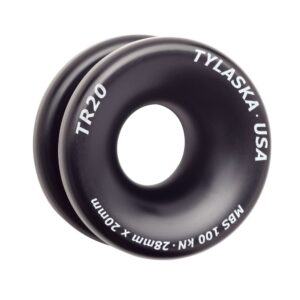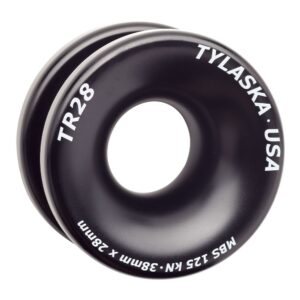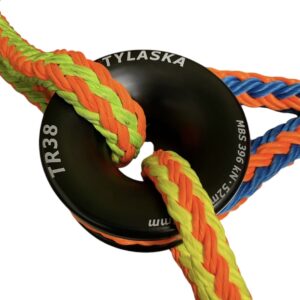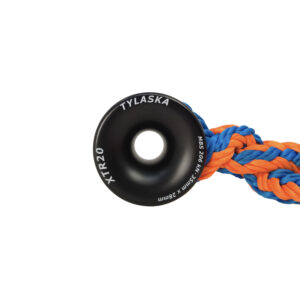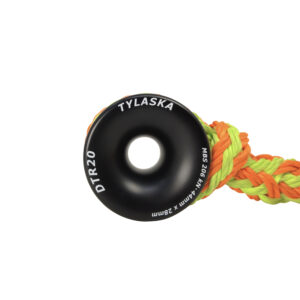 Lighter and smaller than a conventional pulley block, low friction rings have become a popular alternative for many applications where traditional blocks once ruled. Instead of rolling on a pulley sheave, the active line slides on the inside smooth surface of the ring. Another line is spliced tightly around the outside groove of the ring and then spiced back onto itself to create a loop. This loop can then be wrapped around the tree in a choker hitch configuration to secure the ring to the tree. While there is some added friction from the sliding action, the frictional loss is generally small. In many applications this added friction is actually welcome as it can help to reduce the force required to control the load. Lighter, smaller and less expensive than a conventional pulley block, low friction rings are also less prone to failure because there are no moving parts. Their simple design make them practically indestructible.
Lighter and smaller than a conventional pulley block, low friction rings have become a popular alternative for many applications where traditional blocks once ruled. Instead of rolling on a pulley sheave, the active line slides on the inside smooth surface of the ring. Another line is spliced tightly around the outside groove of the ring and then spiced back onto itself to create a loop. This loop can then be wrapped around the tree in a choker hitch configuration to secure the ring to the tree. While there is some added friction from the sliding action, the frictional loss is generally small. In many applications this added friction is actually welcome as it can help to reduce the force required to control the load. Lighter, smaller and less expensive than a conventional pulley block, low friction rings are also less prone to failure because there are no moving parts. Their simple design make them practically indestructible.
Designed in conjunction with professional arborists, Tylaska’s TR series Rigging Rings are low friction rings built for high loads and industrial duty. Machined from 6061 aluminum, Tylaska Rigging Rings feature extra thick side walls and an exaggerated width for improved bend radius. A military spec type III hard coat anodized finish ensures superior durability and wear resistance.
WARNING: Inspect low-friction coating, splices, and line condition before each use. Use professional, qualified splicing to tightly secure low friction rings. Keep rigging and hardware clean and free of abrasive particles. Always follow loading, safety factor, and temperature ratings recommended by line manufacturer. Always monitor heat buildup at the low friction surface and its affects on temperature sensitive rigging lines. Elongation of ring occurs beyond the MBS rating. Do not use rings that are deformed or missing low friction coating.
Showing all 9 results
-
TR14 Rigging Ring
Price range: $29.66 through $32.96Part No. TY2714
-
TR20 Rigging Ring
Price range: $38.75 through $43.06Part No. TY2720
-
TR24 Rigging Ring
Original price was: $72.95.$58.36Current price is: $58.36. Add to cartPart No. TY2724
-
TR28 Rigging Ring
Price range: $66.34 through $73.70Part No. TY2728
-
5/8″ x 12′ Deadeye Sling with chafe guard
Original price was: $109.56.$87.65Current price is: $87.65. Add to cartPart No. TY2711-20
-
5/8″ x 12′ Pocket Sling with chafe guard
Original price was: $191.59.$153.27Current price is: $153.27. Add to cartPart No. TY2710-20
-
TR38 Rigging Ring
Original price was: $214.95.$171.96Current price is: $171.96.Part No. TY2738-BL
-
XTR 20 Rigging Ring
Original price was: $102.95.$82.36Current price is: $82.36. Add to cartPart No. TY2730
-
DTR20 Rigging Ring
Original price was: $102.95.$82.36Current price is: $82.36. Add to cartPart No. TY2732

